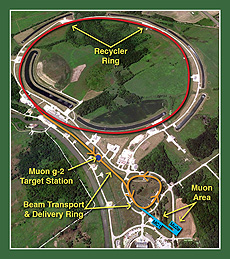Digging begins for Muon g-2 and Mu2e beamlines
 |
| Fermilab has begun construction on new beamlines for its muon programs, Muon g-2 and Mu2e. Image: Fermilab |
Editor's note: The construction of the beamlines for Fermilab's muon experiments necessitates the closure of part of Kautz Road. See the Dec. 8 issue of Fermilab Today for more about the road closure.
This month construction has commenced on beamline tunnel extensions for Fermilab's two muon experiments, Mu2e and Muon g-2.
In the area of the current Delivery Ring (the former Antiproton Debuncher), southwest of the Booster, the existing beam tunnel will be extended approximately 200 feet, at which point it will branch in two separate directions. The Muon g-2 tunnel, about 75 feet long, will terminate in the MC-1 Building, which houses the experiment's muon storage ring. The Mu2e tunnel, around 550 feet long, will head toward a new building to be constructed for the experiment. Construction is expected to take one year. The start of the construction of the Mu2e building is planned for 2015.
Digging for the tunnels began this month. Part of Kautz Road will become permanently inaccessible, with a detour from South Booster Road and Indian Creek Road serving as the new road.
Fermilab Accelerator Division physicist Mary Convery, who oversees the Muon Campus program, coordinated the tunnel designs with Tom Lackowski, project manager; Rod Jedziniak, project design coordinator; and Tim Trout, project construction coordinator, all of FESS.
The primary challenge in constructing the beamlines will be in accommodating fixed features and structures, both man-made and natural.
"The locations of the g-2 and Mu2e buildings were fairly fixed because there are already utility corridors underground," Convery said. "There are also wetlands that we are trying not to disturb."
Convery said that these physical constraints were important considerations in designing the experiments' beamlines, since the space available to accomplish the necessary beam manipulations was limited.
"It is not only the geometry of the beamlines that we have to conform to," Lackowski said. "We also have to make sure the many services — the cable trays and the water services for cooling — are all coordinated."
Because the two muon experiments use the same beamlines at different energies, they cannot be run simultaneously.
For both experiments, protons will proceed through the Linac, course through the Booster and then travel through the Recycler. A set of beamlines connects the Recycler to the Muon Campus. For the Muon g-2 experiment, the proton beam hits a target, converting the beam to a mixture of pions, protons and muons. The particles circle the Muon Delivery Ring several times, where protons are then removed and the remaining pions decay into muons. When the Muon g-2 experiment is taking data, the muon beam will continue to the experiment in the MC-1 Building.
In contrast, for the Mu2e experiment, the protons bypass the target station and are transported to the Delivery Ring. The Mu2e protons also circle the Delivery Ring, then continue as an all-proton beam to the target in the Mu2e building area.
Convery says work is also being done on other technical upgrades, such as installing magnets, along the beamline route.
She expects the Muon g-2 experiment to begin in 2017, with Mu2e starting later, as scheduled.
"Fermilab people have worked together for many years on various beamline projects," Lackowski said. "We have had a very tight relationship with Mary and other colleagues, so we believe the Muon Campus tunnel project will go well."
—Rich Blaustein
|